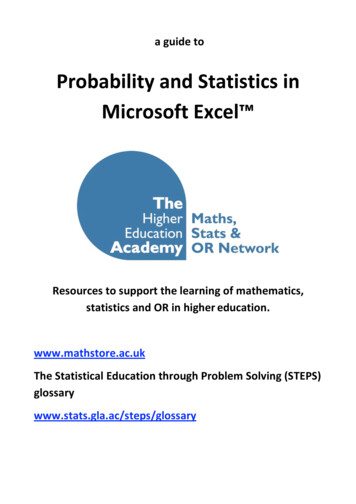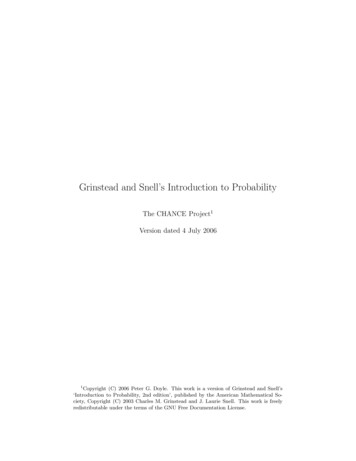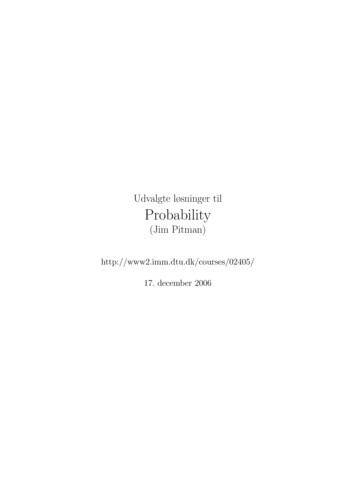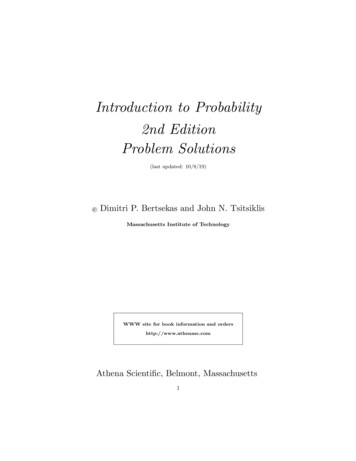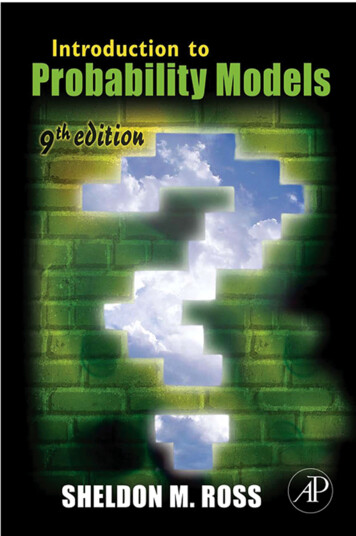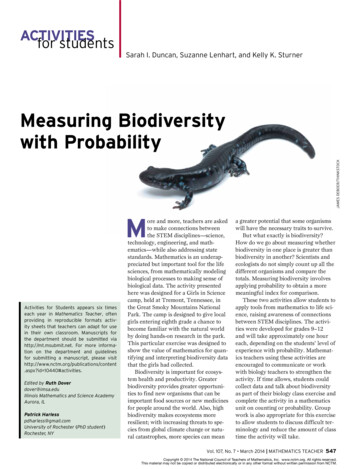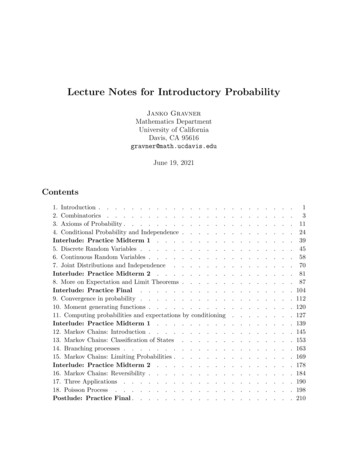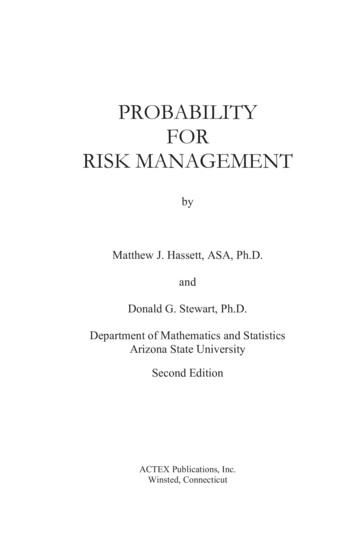
Transcription
PROBABILITYFORRISK MANAGEMENTbyMatthew J. Hassett, ASA, Ph.D.andDonald G. Stewart, Ph.D.Department of Mathematics and StatisticsArizona State UniversitySecond EditionACTEX Publications, Inc.Winsted, Connecticut
Copyright 2006, 2009, 2013by ACTEX Publications, Inc.No portion of this book may be reproduced inany form or by any means without prior writtenpermission from the copyright owner.Requests for permission should be addressed toACTEX Publications, Inc.P.O. Box 974Winsted, CT 06098Manufactured in the United States of America10 9 8 7 6 5 4Cover design by Christine PhelpsLibrary of Congress Cataloging-in-Publication DataHassett, Matthew J.Probability for risk management / by Matthew J. Hassett and DonaldG. Stewart. -- 2nd ed.p. cm.Includes bibliographical references and index.ISBN-13: 978-1-56698-583-3 (pbk. : alk. paper)ISBN-10: 1-56698-548-X (alk. paper)1. Risk management--Statistical methods. 2. Risk (Insurance)-Statistical methods. 3. Probabilities. I. Stewart, Donald, 1933- II. Title.HD61.H35 2006658.15'5--dc222006021589ISBN-13: 978-1-56698-548-2ISBN-10: 1-56698-548-X
Prefaceto the Second EditionThe major change in this new edition is an increase in the number ofchallenging problems. This was requested by our readers. Since theactuarial examinations are an excellent source of challenging problems,we have added 109 sample exam problems to our exercise sections.(Detailed solutions can be found in the solutions manual). We thank theSociety of Actuaries for permission to use these problems.We have added three new sections which cover the bivariate normaldistribution, joint moment generating functions and the multinomialdistribution.The authors would like to thank the second edition review team:Leonard A. Asimow, ASA, Ph.D. Robert Morris University, andKrupa S. Viswanathan, ASA, Ph.D., Temple University.Finally we would like to thank Gail Hall for her editorial work on thetext and Marilyn Baleshiski for putting the book together.Matt HassettDon StewartTempe, ArizonaJune, 2006
PrefaceThis text provides a first course in probability for students with a basiccalculus background. It has been designed for students who are mostlyinterested in the applications of probability to risk management in vitalmodern areas such as insurance, finance, economics, and health sciences.The text has many features which are tailored for those students.Integration of applications and theory. Much of modern probabilitytheory was developed for the analysis of important risk managementproblems. The student will see here that each concept or techniqueapplies not only to the standard card or dice problems, but also to theanalysis of insurance premiums, unemployment durations, and lives ofmortgages. Applications are not separated as if they were an afterthoughtto the theory. The concept of pure premium for an insurance isintroduced in a section on expected value because the pure premium is anexpected value.Relevant applications. Applications will be taken from texts, publishedstudies, and practical experience in actuarial science, finance, andeconomics.Development of key ideas through well-chosen examples. The text isnot abstract, axiomatic or proof-oriented. Rather, it shows the studenthow to use probability theory to solve practical problems. The studentwill be introduced to Bayes’ Theorem with practical examples usingtrees and then shown the relevant formula. Expected values ofdistributions such as the gamma will be presented as useful facts, withproof left as an honors exercise. The student will focus on applyingBayes’ Theorem to disease testing or using the gamma distribution tomodel claim severity.Emphasis on intuitive understanding. Lack of formal proofs does notcorrespond to a lack of basic understanding. A well-chosen tree exampleshows most students what Bayes’ Theorem is really doing. A simple
viPrefaceexpected value calculation for the exponential distribution or apolynomial density function demonstrates how expectations are found.The student should feel that he or she understands each concept. Thewords “beyond the scope of this text” will be avoided.Organization as a useful future reference. The text will present keyformulas and concepts in clearly identified formula boxes and provideuseful summary tables. For example, Appendix B will list all majordistributions covered, along with the density function, mean, variance,and moment generating function of each.Use of technology. Modern technology now enables most students tosolve practical problems which were once thought to be too involved.Thus students might once have integrated to calculate probabilities for anexponential distribution, but avoided the same problem for a gammadistribution with 5 and 3. Today any student with a TI-83calculator or a personal computer version of MATLAB or Maple orMathematica can calculate probabilities for the latter distribution. Thetext will contain boxed Technology Notes which show what can be donewith modern calculating tools. These sections can be omitted by studentsor teachers who do not have access to this technology, or required forclasses in which the technology is available.The practical and intuitive style of the text will make it useful for anumber of different course objectives.A first course in probability for undergraduate mathematics majors.This course would enable sophomores to see the power and excitementof applied probability early in their programs, and provide an incentive totake further probability courses at higher levels. It would be especiallyuseful for mathematics majors who are considering careers in actuarialscience.An incentive course for talented business majors. The probabilitymethods contained here are used on Wall Street, but they are notgenerally required of business students. There is a large untapped pool ofmathematically-talented business students who could use this courseexperience as a base for a career as a “rocket scientist” in finance or as amathematical economist.
PrefaceviiAn applied review course for theoretically-oriented students. Manymathematics majors in the United States take only an advanced, prooforiented course in probability. This text can be used for a review of basicmaterial in an understandable applied context. Such a review may beparticularly helpful to mathematics students who decide late in theirprograms to focus on actuarial careers.The text has been class-tested twice at Arizona State University. Eachclass had a mixed group of actuarial students, mathematically- talentedstudents from other areas such as economics, and interested mathematicsmajors. The material covered in one semester was Chapters 1-7, Sections8.1-8.5, Sections 9.1-9.4, Chapter 10 and Sections 11.1-11.4. The text isalso suitable for a pre-calculus introduction to probability using Chapters1-6, or a two-semester course which covers the entire text. As always,the amount of material covered will depend heavily on the preferences ofthe instructor.The authors would like to thank the following members of a review teamwhich worked carefully through two draft versions of this text:Sam Broverman, ASA, Ph.D., University of TorontoSheldon Eisenberg, Ph.D., University of HartfordBryan Hearsey, ASA, Ph.D., Lebanon Valley CollegeTom Herzog, ASA, Ph.D., Department of HUDEugene Spiegel, Ph.D., University of ConnecticutThe review team made many valuable suggestions for improvement andcorrected many errors. Any errors which remain are the responsibility ofthe authors.A second group of actuaries reviewed the text from the point of view ofthe actuary working in industry. We would like to thank WilliamGundberg, EA, Brian Januzik, ASA, and Andy Ribaudo, ASA, ACAS,FCAS, for valuable discussions on the relation of the text material to theday-to-day work of actuarial science.Special thanks are due to others. Dr. Neil Weiss of Arizona StateUniversity was always available for extremely helpful discussionsconcerning subtle technical issues. Dr. Michael Ratliff, ASA, ofNorthern Arizona University and Dr. Stuart Klugman, FSA, of DrakeUniversity read the entire text and made extremely helpful suggestions.
viiiPrefaceThanks are also due to family members. Peggy Craig-Hassett providedwarm and caring support throughout the entire process of creating thistext. John, Thia, Breanna, JJ, Laini, Ben, Flint, Elle and Sabrina allenriched our lives, and also provided motivation for some of ourexamples.We would like to thank the ACTEX team which turned the idea for thistext into a published work. Richard (Dick) London, FSA, first proposedthe creation of this text to the authors and has provided editorial guidancethrough every step of the project. Denise Rosengrant did the daily workof turning our copy into an actual book.Finally a word of thanks for our students. Thank you for working with usthrough two semesters of class-testing, and thank you for your positiveand cooperative spirit throughout. In the end, this text is not ours. It isyours because it will only achieve its goals if it works for you.May, 1999Tempe, ArizonaMatthew J. HassettDonald G. Stewart
Table of ContentsPreface to the Second Edition iiiPreface vChapter 1: Probability: A Tool for Risk Management 11.11.21.31.41.5Who Uses Probability? . 1An Example from Insurance . 2Probability and Statistics . 3Some History . 3Computing Technology . 5Chapter 2: Counting for Probability 72.1What Is Probability? . 72.2The Language of Probability; Sets,Sample Spaces and Events . 92.3Compound Events; Set Notation . 142.3.1 Negation . 142.3.2 The Compound Events A or B, A and B . 152.3.3 New Sample Spaces from Old:Ordered Pair Outcomes . 172.4Set Identities . 182.4.1 The Distributive Laws for Sets . 182.4.2 De Morgan’s Laws . 192.5Counting . 202.5.1 Basic Rules . 202.5.2 Using Venn Diagrams in Counting Problems . 232.5.3 Trees . 25
xContents2.5.42.5.52.5.62.5.72.5.82.5.9The Multiplication Principle for Counting . 27Permutations . 29Combinations . 33Combined Problems . 35Partitions . 36Some Useful Identities . 382.6Exercises . 392.7Sample Actuarial Examination Problem . 44Chapter 3: Elements of Probability 453.1Probability by Counting for Equally Likely Outcomes . 453.1.1 Definition of Probability forEqually Likely Outcomes . 453.1.2 Probability Rules for Compound Events . 463.1.3 More Counting Problems . 493.2Probability When Outcomes Are Not Equally Likely. 523.2.1 Assigning Probabilities to a Finite Sample Space . 533.2.2 The General Definition of Probability. 543.3Conditional Probability . 553.3.1 Conditional Probability by Counting . 553.3.2 Defining Conditional Probability . 573.3.3 Using Trees in Probability Problems . 593.3.4 Conditional Probabilities in Life Tables . 603.4Independence . 613.4.1 An Example of Independent Events;The Definition of Independence . 613.4.2 The Multiplication Rule for Independent Events . 633.5Bayes’ Theorem . 653.5.1 Testing a Test: An Example . 653.5.2 The Law of Total Probability; Bayes’ Theorem . 673.6Exercises. 713.7Sample Actuarial Examination Problems. 76
ContentsxiChapter 4: Discrete Random Variables 834.1Random Variables . 834.1.1 Defining a Random Variable. 834.1.2 Redefining a Random Variable . 854.1.3 Notation; The Distinction Between X and x . 854.2The Probability Function of a Discrete Random Variable . 864.2.1 Defining the Probability Function . 864.2.2 The Cumulative Distribution Function. 874.3Measuring Central Tendency; Expected Value . 914.3.1 Central Tendency; The Mean . 914.3.2 The Expected Value of Y aX . 944.3.3 The Mode . 964.4Variance and Standard Deviation . 974.4.1 Measuring Variation . 974.4.2 The Variation and Standard Deviation of Y aX . 994.4.3 Comparing Two Stocks . 1004.4.4 z-scores; Chebychev’s Theorem. 1024.5Population and Sample Statistics . 1054.5.1 Population and Sample Mean . 1054.5.2 Using Calculators for theMean and Standard Deviation . 1084.6Exercises. 1084.7Sample Actuarial Examination Problems. 111Chapter 5: Commonly Used Discrete Distributions 1135.1The Binomial Distribution . 1135.1.1 Binomial Random Variables . 1135.1.2 Binomial Probabilities . 1155.1.3 Mean and Variance of the Binomial Distribution . 1175.1.4 Applications . 1195.1.5 Checking Assumptions for Binomial Problems . 1215.2The Hypergeometric Distribution . 1225.2.15.2.2An Example . 122The Hypergeometric Distribution . 123
xiiContents5.2.35.2.4The Mean and Variance of theHypergeometric Distribution. 124Relating the Binomial andHypergeometric Distributions . 1255.3The Poisson Distribution . 1265.3.1 The Poisson Distribution . 1265.3.2 The Poisson Approximation to theinomial for Large n and Small p . 1285.3.3 Why Poisson Probabilities ApproximateBinomial Probabilities . 1305.3.4 Derivation of the Expected Value of aPoisson Random Variable . 1315.4The Geometric Distribution. 1325.4.1 Waiting Time Problems . 1325.4.2 The Mean and Variance of theGeometric Distribution . 1345.4.3 An Alternate Formulation of theGeometric Distribution . 1345.5The Negative Binomial Distribution . 1365.5.1 Relation to the Geometric Distribution . 1365.5.2 The Mean and Variance of the NegativeBinomial Distribution . 1385.6The Discrete Uniform Distribution . 1415.7Exercises. 1425.8Sample Actuarial Exam Problems . 147Chapter 6: Applications for Discrete Random Variables 1496.1Functions of Random Variables and Their Expectations . 1496.1.1 The Function Y aX b . 1496.1.2 Analyzing Y f ( X ) in General . 1506.1.3 Applications . 1516.1.4 Another Way to Calculate the Variance of aRandom Variable. 1536.2Moments and the Moment Generating Function . 1556.2.1 Moments of a Random Variable . 155
.9The Moment Generating Function . 155Moment Generating Function for theBinomial Random Variable . 157Moment Generating Function for thePoisson Random Variable . 158Moment Generating Function for theGeometric Random Variable . 158Moment Generating Function for theNegative Binomial Random Variable . 159Other Uses of the Moment Generating Function . 159A Useful Identity . 160Infinite Series and theMoment Generating Function . 1606.3Distribution Shapes . 1616.4Simulation of Discrete Distributions . 1646.4.1 A Coin-Tossing Example . 1646.4.2 Generating Random Numbers from [0,1). 1666.4.3 Simulating Any Finite Discrete Distribution. 1686.4.4 Simulating a Binomial Distribution . 1706.4.5 Simulating a Geometric Distribution . 1706.4.6 Simulating a Negative Binomial Distribution . 1716.4.7 Simulating Other Distributions . 1716.5Exercises. 1716.6Sample Actuarial Exam Problems . 174Chapter 7: Continuous Random Variables 1757.1Defining a Continuous Random Variable . 1757.1.1 A Basic Example . 1757.1.2 The Density Function and Probabilities forContinuous Random Variables. 1777.1.3 Building a Straight-Line Density Functionfor an Insurance Loss . 1797.1.4 The Cumulative Distribution Function F ( x) . 1807.1.5 A Piecewise Density Function . 1817.2The Mode, the Median, and Percentiles . 184
xivContents7.3The Mean and Variance of aContinuous Random Variable . 1877.3.1 The Expected Value of aContinuous Random Variable . 1877.3.2 The Expected Value of a Function of aRandom Variable. 1887.3.3 The Variance of a Continuous Random Variable .1897.4Exercises. 1927.5Sample Actuarial Examination Problems. 193Chapter 8: Commonly Used Continuous Distributions 1958.1The Uniform Distribution. 1958.1.1 The Uniform Density Function . 1958.1.2 The Cumulative Distribution Function for aUniform Random Variable . 1968.1.3 Uniform Random Variables for Lifetimes;Survival Functions. 1978.1.4 The Mean and Variance of theUniform Distribution . 1998.1.5 A Conditional Probability Problem Involving theUniform Distribution . 2008.2The Exponential Distribution . 2018.2.1 Mathematical Preliminaries. 2018.2.2 The Exponential Density: An Example . 2028.2.3 The Exponential Density Function . 2038.2.4 The Cumulative Distribution Function andSurvival Function of theExponential Random Variable . 2058.2.5 The Mean and Variance of theExponential Distribution . 2058.2.6 Another Look at the Meaning of theDensity Function . 2068.2.7 The Failure (Hazard) Rate . 2078.2.8 Use of the Cumulative Distribution Function . 2088.2.9 Why the Waiting Time is Exponential for EventsWhose Number Follows a Poisson Distribution . 2098.2.10 A Conditional Probability Problem Involving theExponential Distribution . 210
Contentsxv8.3The Gamma Distribution . 2118.3.1 Applications of the Gamma Distribution . 2118.3.2 The Gamma Density Function . 2128.3.3 Sums of Independent ExponentialRandom Variables . 2138.3.4 The Mean and Variance of theGamma Distribution . 2148.3.5 Notational Differences Between Texts. 2158.4The Normal Distribution . 2168.4.1 Applications of the Normal Distribution . 2168.4.2 The Normal Density Function . 2188.4.3 Calculation of Normal Probabilities;The Standard Normal . 2198.4.4 Sums of Independent, Identically Distributed,Random Variables . 2248.4.5 Percentiles of the Normal Distribution . 2268.4.6 The Continuity Correction . 2278.5The Lognormal Distribution. 2288.5.1 Applications of the Lognormal Distribution . 2288.5.2 Defining the Lognormal Distribution . 2288.5.3 Calculating Probabilities for aLognormal Random Variable . 2308.5.4 The Lognormal Distribution for a Stock Price . 2318.6The Pareto Distribution . 2328.6.1 Application of the Pareto Distribution . 2328.6.2 The Density Function of thePareto Random Variable . 2328.6.3 The Cumulative Distribution Function;Evaluating Probabilities . 2338.6.4 The Mean and Variance of thePareto Distribution . 2348.6.5 The Failure Rate of a Pareto Random Variable . 2348.7The Weibull Distribution . 2358.7.1 Application of the Weibull Distribution . 2358.7.2 The Density Function of theWeibull Distribution . 2358.7.3 The Cumulative Distribution Function andProbability Calculations . 236
xviContents8.7.48.7.5The Mean and Variance of the WeibullDistribution . 237The Failure Rate of a Weibull Random Variable .2388.8The Beta Distribution . 2398.8.1 Applications of the Beta Distribution. 2398.8.2 The Density Function of the Beta Distribution . 2398.8.3 The Cumulative Distribution Function andProbability Calculations . 2408.8.4 A Useful Identity . 2418.8.5 The Mean and Variance of aBeta Random Variable . 2418.9Fitting Theoretical Distributions to Real Problems . 2428.10 Exercises. 2438.11 Sample Actuarial Examination Problems. 250Chapter 9: Applications for Continuous Random Variables 2559.1Expected Value of a Function of a Random Variable . 2559.1.1 Calculating E[ g ( X )] . 2559.1.2 Expected Value of a Loss or Claim . 2559.1.3 Expected Utility . 2579.2Moment Generating Functions forContinuous Random Variables. 2589.2.1 A Review . 2589.2.2 The Gamma Moment Generating Function. 2599.2.3 The Normal Moment Generating Function . 2619.3The Distribution of Y g ( X ) . 2629.3.1 An Example . 2629.3.2 Using FX ( x) to find FY ( y ) for Y g ( X ) . 2639.3.3 Finding the Density Function for Y g ( X )When g ( X ) Has an Inverse Function . 2659.4Simulation of Continuous Distributions . 2689.4.1 The Inverse Cumulative DistributionFunction Method . 268
Contentsxvii9.4.29.4.3Using the Inverse Transformation Method toSimulate an Exponential Random Variable . 270Simulating Other Distributions . 2719.5Mixed Distributions. 2729.5.1 An Insurance Example . 2729.5.2 The Probability Functionfor a Mixed Distribution . 2749.5.3 The Expected Value of a Mixed Distribution . 2759.5.4 A Lifetime Example . 2769.6Two Useful Identities . 2779.6.1 Using the Hazard Rate to Findthe Survival Function . 2779.6.2 Finding E ( X ) Using S ( x) . 2789.7Exercises. 2809.8Sample Actuarial Examination Problems. 283Chapter 10: Multivariate Distributions 28710.1 Joint Distributions for Discrete Random Variables. 28710.1.1 The Joint Probability Function . 28710.1.2 Marginal Distributions forDiscrete Random Variables . 28910.1.3 Using the Marginal Distributions . 29110.2 Joint Distributions for Continuous Random Variables . 29210.2.1 Review of the Single Variable Case . 29210.2.2 The Joint Probability Density Function forTwo Continuous Random Variables . 29210.2.3 Marginal Distributions forContinuous Random Variables. 29610.2.4 Using Continuous Marginal Distributions . 29710.2.5 More General Joint Probability Calculations . 29810.3 Conditional Distributions . 30010.3.1 Discrete Conditional Distributions . 30010.3.2 Continuous Conditional Distributions . 30210.3.3 Conditional Expected Value. 304
xviiiContents10.4 Independence for Random Variables . 30510.4.1 Independence for Discrete Random Variables . 30510.4.2 Independence for Continuous Random Variables .30710.5 The Multinomial Distribution . 30810.6 Exercises. 31010.7 Sample Actuarial Examination Problems. 312Chapter 11: Applying Multivariate Distributions 32111.1 Distributions of Functions of Two Random Variables. 32111.1.1 Functions of X and Y . 32111.1.2 The Sum of Two Discrete Random Variables. 32111.1.3 The Sum of Independent DiscreteRandom Variables . 32211.1.4 The Sum of Continuous Random Variables . 32311.1.5 The Sum of Independent ContinuousRandom Variables . 32511.1.6 The Minimum of Two Independent ExponentialRandom Variables . 32611.1.7 The Minimum and Maximum of any TwoIndependent Random Variables . 32711.2 Expected Values of Functions of Random Variables . 32911.2.1 Finding E[ g ( X , Y )] . 32911.2.2 Finding E ( X Y ) . 33011.2.3 The Expected Value of XY . 33111.2.4 The Covariance of X and Y . 33411.2.5 The Variance of X Y . 33711.2.6 Useful Properties of Covariance . 33911.2.7 The Correlation Coefficient . 34011.2.8 The Bivariate Normal Distribution. 34211.3 Moment Generating Functions for Sums ofIndependent Random Variables;Joint Moment Generating Functions .
Gundberg, EA, Brian Januzik, ASA, and Andy Ribaudo, ASA, ACAS, FCAS, for valuable discussions on the re lation of the text material to the day-to-day work of actuarial science. Special thanks are due to others. Dr. Neil Weiss of Arizona State University was always available for extremely he

